Content
- 1 What it looks like and where it grows
- 2 Chemical composition
- 3 Healing properties of the herb goldenrod (golden rod)
- 4 Is goldenrod possible for children
- 5 The use of goldenrod in traditional medicine
- 6 Useful properties and contraindications of goldenrod honey
- 7 Collection and storage of goldenrod
- 8 Side effects of goldenrod and contraindications
- 9 Conclusion
The medicinal properties and contraindications of goldenrod are extremely important to consider when combining it with other medicinal herbs. Due to the abundance of constituent components, therapy can lead to unpredictable results. When used correctly, the plant can strengthen the body's defenses and get rid of a number of serious diseases.
What it looks like and where it grows
Goldenrod is a perennial herb belonging to the Astrov family. The name is translated from Latin as "golden rod" or "strong", "healthy". The plant has an erect stem, the height of which reaches 100 cm. A distinctive feature of the plant is the root deeply embedded in the ground. The color of the bark of the stem can be either purple or emerald. The leafy part is ovoid or oval in shape. The lower leaves are longer than the upper ones.
During the flowering period, goldenrod is covered with yellow flowers that have a delicate pleasant aroma. Budding begins in late summer and lasts until October. In total, there are about 80 varieties of goldenrod, but only 20 of them are widespread in horticulture. Common goldenrod is found in Western Siberia, the Far East and the Caucasus.
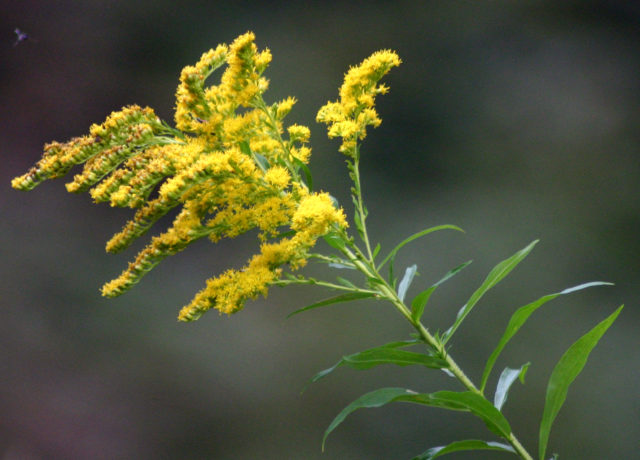
Chemical composition
The healing properties of the goldenrod plant are due to its rich composition. In addition, it is considered not fully understood. The highest concentration of useful components is found in the stem. The rhizome of the plant is a rich source of inulin, which is a prebiotic from the group of polysaccharides. Goldenrod fruits contain a huge amount of fatty oils. And the inflorescences, in turn, are famous for the content of monosaccharides and carbohydrates. Goldenrod contains the following substances:
- alkaloids;
- lipophilic elements;
- chlorophyll;
- resin;
- coumarins;
- essential oils;
- diterpenoids;
- organic phenol carboxylic acids;
- tannins;
- vitamin C;
- saponins;
- group B nutrients;
- Sahara.
Healing properties of the herb goldenrod (golden rod)
Due to its beneficial properties, goldenrod is widely used in alternative medicine. It was used more than 300 years ago. The main advantage of the plant is its natural composition, which significantly reduces the likelihood of side effects. In alternative medicine, the golden rod is primarily considered a diuretic. It has a pronounced diuretic effect.
Due to the rich content of flavonoids, the plant eliminates diseases of the capillaries and blood vessels. And the antifungal effect makes it effective against candidiasis. The beneficial properties of common goldenrod include the following:
- diuretic action;
- wound healing effect;
- antibacterial properties;
- antiviral action;
- elimination of puffiness;
- antispasmodic effect;
- stopping bleeding;
- antifungal action;
- anti-inflammatory effect;
- prevention of oncological processes;
- strengthening of immunity;
- choleretic action.
For women
The plant is of particular value for the female hormonal system. It fights genitourinary diseases by leveling hormone levels in the body. The anti-inflammatory properties allow the plant to be used in the fight against certain gynecological diseases. In addition, goldenrod has a positive effect on the quality of the egg, which increases the chances of a successful pregnancy. According to many years of research, goldenrod treats the following diseases:
- adnexitis;
- cystic formations;
- candidiasis;
- erosion;
- vaginitis;
- bartholinitis.
To achieve the desired therapeutic effect, infusions and decoctions of the plant are used as a solution for douching. At the same time, internal drug intake is practiced. This helps to improve the effectiveness of therapy.
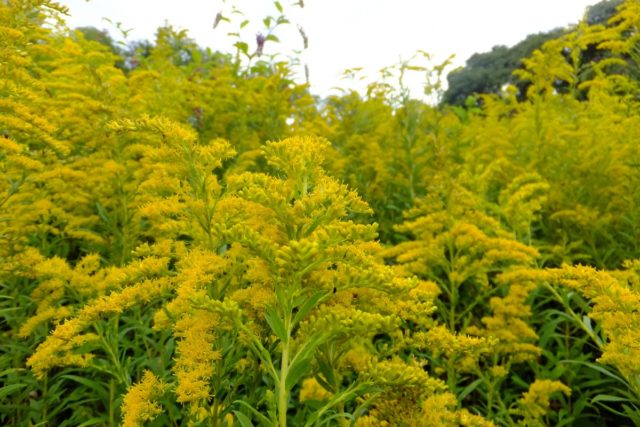
For men
Common goldenrod can be used for the treatment of purely male diseases. It is effective against ailments of the reproductive system. It normalizes hormonal levels, helping to stabilize spermatogenesis. The positive effect of the plant on blood vessels helps to cope with congestion in the small pelvis. This provides relief from impotence and prostate adenoma. After treatment with a golden rod, the quality of the seminal fluid improves, which is reflected in the future offspring.
It should be remembered that goldenrod has not only medicinal properties, but also contraindications for men. These include kidney disease and circulatory disorders.
During pregnancy
The ban on the use of goldenrod during pregnancy applies only to the first trimester. During this period, the fetus is less resistant to the influence of environmental factors. Carrying out herbal medicine can affect its viability.
In subsequent trimesters, the use of medicines based on goldenrod is not prohibited. An exception is the internal intake of tinctures and decoctions. They are used only externally. An indication for their use may be back pain. If they appear, rub the lower back with alcohol tincture of goldenrod. It can also be used to heal sores in the mouth. In this case, the agent is used for rinsing.
After giving birth, you must completely abandon the use of goldenrod. Its components can penetrate into breast milk and have a toxic effect on the baby. A dose of a golden rod, calculated for an adult, can significantly harm a baby.
Is goldenrod possible for children
Children under 3 years old are not recommended to be treated with goldenrod. At preschool age, only external use of plant derivatives is permissible. In other cases, the possibility of using a water decoction is discussed with a pediatrician.
The use of goldenrod in traditional medicine
Goldenrod helps against many diseases and pathological processes. For this reason, it is widely used in homeopathy and alternative medicine. Decoctions, infusions and alcoholic tinctures are prepared from the plant. The latter are often used as a compress and to cauterize problem areas. The golden rod flavonoid complex provides powerful hypoazotemic and diuretic effects. It restores water-salt metabolism and levels the pH of urine. That is why goldenrod is often used to eliminate urate and oxalate stones.
Goldenrod infusion
Goldenrod infusion is prepared at the rate of: 1 tbsp. l. dry mixture for 200 ml of water.The leaves are poured with liquid at night, and in the morning they are filtered. The finished medicine is drunk in small sips throughout the day. Reception is carried out 20-30 minutes before meals. Such treatment allows you to get rid of cough, normalize kidney function and strengthen immunity. The duration of therapy in each individual case will differ.
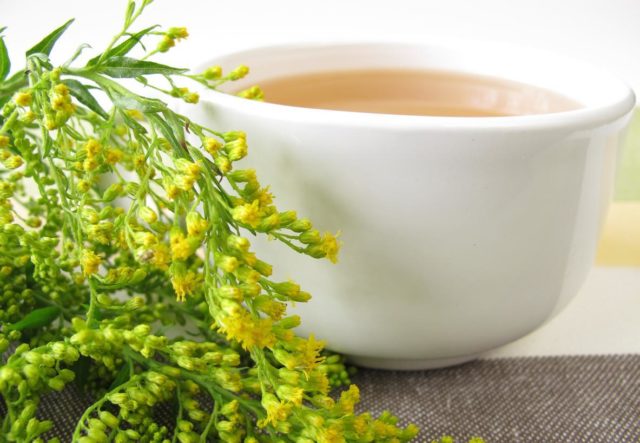
Goldenrod broth
For the broth, use the same ratio of components as for the infusion. But the leafy part is poured with hot water, at a temperature of at least 90 ° C. Then the agent is brought to a boil in a water bath. After removing from the heat, it is insisted for 3 hours. Before using, filter the broth. It should be taken in 30 ml 3 times a day.
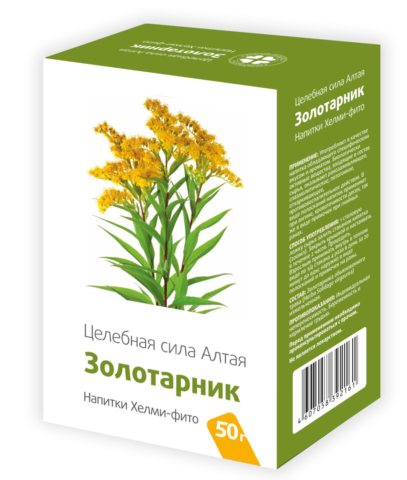
Alcohol tincture of goldenrod
For kidney diseases, alcohol tincture of goldenrod is often used. It is prepared from young plant stems. They are crushed and poured with vodka. For 500 ml of an alcohol base, you will need 7 tbsp. l. raw materials. The plant is infused in a glass container with a sealed lid. The duration of the infusion is 3 weeks. After the specified time, the tincture is filtered and poured into another container.
Reception is carried out in 1 tsp. 1 per day. The tincture is preliminarily diluted with a small amount of pure water. Inside, it is recommended to take it to get rid of inflammatory processes, kidney disease and bile congestion. For external use, compresses with goldenrod tincture are used.

Goldenrod tea
For the preparation of medicinal tea 1 tbsp. l. plant stems are poured with 300 ml of hot water. After 3-5 minutes, the drink is poured into cups. It helps prevent diseases of the urinary system and strengthens the immune system. Regular intake of goldenrod tea reduces the likelihood of kidney stones.
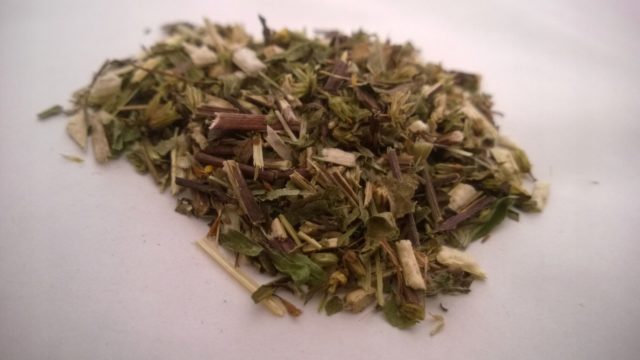
Bath broth with goldenrod
Goldenrod baths are indicated for people suffering from tuberculosis and skin diseases. 50 g of dry mix should be added to 10 liters of water. The container is put on fire and brought to a boil. Then the agent is infused for 2 hours. After a specified time, it is added to the bath, preheating. The bathing procedure lasts at least 20 minutes. It is recommended to exercise it at least 1 time a week.
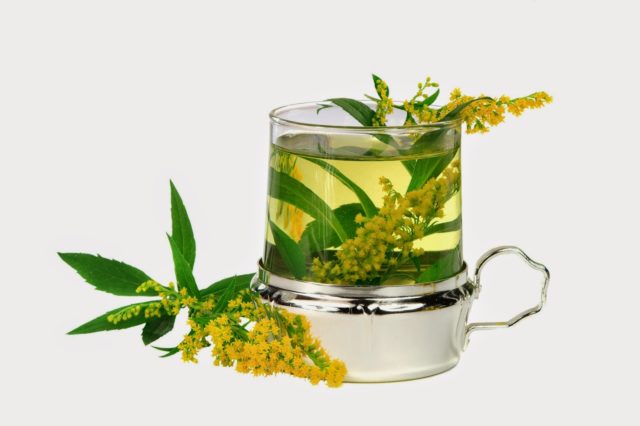
Compresses
For compresses, use alcohol tincture or oil. The first remedy is prepared for 3 weeks in a dark place. For the preparation of oil extract 2-3 tbsp. l. goldenrod inflorescences are poured with a mixture of olive and sea buckthorn oils. A gauze swab is soaked in the resulting substance, after which it is applied to the problem area. After 15 minutes, the compress is removed. The procedure is carried out twice a day.

Goldenrod ointment
If you need to treat skin conditions, you can use goldenrod ointment. It will require 4 tbsp. l. dried inflorescences and 100 g of pork fat. First, the fat is melted in a water bath, after which it is mixed with the main component. The mixture is boiled thoroughly for half an hour. The finished product is filtered and used for its intended purpose. The ointment helps to cope with focal baldness, local skin peeling and fungal diseases.

Useful properties and contraindications of goldenrod honey
Goldenrod honey is considered one of the most common folk remedies. It is classified as a rare variety that has a lot of useful qualities. The product is distinguished by its dark yellow color and thick consistency.Most often, it is used to treat burns, colitis, insomnia, and various skin lesions. The medicinal properties of goldenrod honey include the following:
- strengthening the heart muscle;
- increased visual acuity;
- treatment of colds;
- cleansing the kidneys;
- acceleration of the skin regeneration process;
- strengthening immunity.
The main contraindication to the use of golden rod honey is individual intolerance. Beekeeping products are quite strong allergens, so they should be used with extreme caution. It is also unacceptable to use honey for patients with diabetes mellitus.
Collection and storage of goldenrod
The plant is recommended to be harvested at the beginning of flowering. It falls on the first days of August. It is not necessary to pluck the entire aerial part, there are enough inflorescences. The collected raw materials are distributed into several bundles and in this form are sent to dry. They are hung in a dark place with good ventilation.
The procured raw materials are stored in paper bags or fabric bags. The best storage place is a dark room with a temperature not exceeding 30 ° C. Subject to all conditions, the medicinal product retains its properties for 2 years.
Side effects of goldenrod and contraindications
Before using goldenrod herb, you need to study the contraindications. This will get rid of the possible consequences. Special care should be taken in people prone to allergic reactions. Other contraindications for a remedy include:
- bilateral kidney inflammation;
- age less than 15 years;
- acute form of nephrological diseases;
- pregnancy and breastfeeding;
- heart failure;
- the presence of kidney stones;
- liver disease.
The plant contains toxic components. If ingested in excessive quantities, they can provoke poisoning. Possible side effects include:
- excessive sweating;
- vomiting;
- upset stool;
- heart palpitations;
- dizziness;
- tremors in the limbs;
- insomnia.
Conclusion
The healing properties and contraindications of goldenrod are a very interesting topic for study. Despite the natural origin of the product, its use contains a number of nuances. Subject to all the rules, the golden rod can bring tremendous health benefits.

